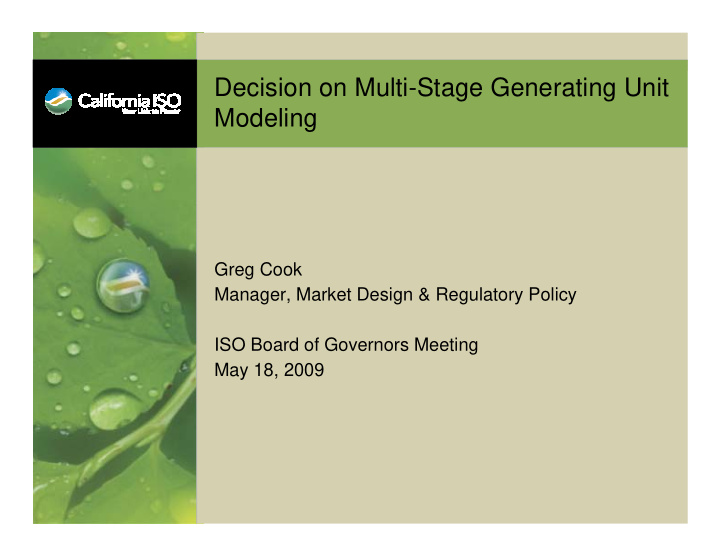



Decision on Multi-Stage Generating Unit Modeling Greg Cook Manager, Market Design & Regulatory Policy ISO Board of Governors Meeting May 18, 2009
Why do we need multi-stage generation unit modeling? ! Multi-stage generation units have multiple operating configurations ! Provides operating flexibility ! Requires explicit modeling of various configurations ! Current market software does not support effective dispatch of multi-stage generation units ! Forbidden operating region functionality problematic in MRTU market simulation and not implemented ! Manual methods currently being used to ensure feasible dispatch . Slide 2
More accurate modeling of multi-stage generating units will provide numerous benefits. ! The ISO markets ! Dampened price volatility ! More accurate price signals ! Employ units’ flexibility ! Less Exceptional Dispatch ! Fewer uninstructed deviations ! Multi-stage units ! Offer units’ flexibility ! Less manual management of dispatches ! Kept in the market ! Accurate, feasible dispatches ! Reduced incentive to deviate from dispatches . Slide 3
Input from key players used to develop the proposal. ! Conducted stakeholder process from November through April ! Benchmarking analysis of other ISOs ! ERCOT, PJM, NYISO ! Extensive discussions with generation unit owners ! Worked with software vender to balance design needs and software constraints . Slide 4
Sets bidding and settlement policy for multi-stage generation units. Proposal establishes rules for: ! ! eligibility information submittal ! ! bidding parameters local market power mitigation ! self-schedules ! bid cost recovery ! outage reporting ! resource adequacy obligations ! ancillary service certification Provide maximum flexibility within software performance constraints . Slide 5
Proposal balances accurate modeling of flexibility with software performance. ! Day-ahead market – propose up to 10 configurations ! At least one configuration’s bid must cover Resource Adequacy offer obligation ! Real-time market – propose up to 3 configurations ! Requirements on configuration-level bids ensure that day-ahead commitments and Resource Adequacy obligations are met As much flexibility as the software can accommodate will be implemented . Slide 6
Management requests approval of the Proposal. ! Wide stakeholder support ! Proposal balances flexibility and software performance concerns ! Current implementation target is Q4 of 2009 pending vendor evaluation of requirements . Slide 7
Recommend
More recommend